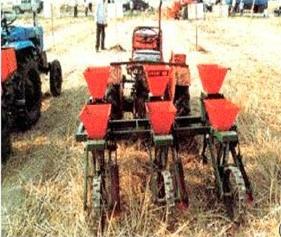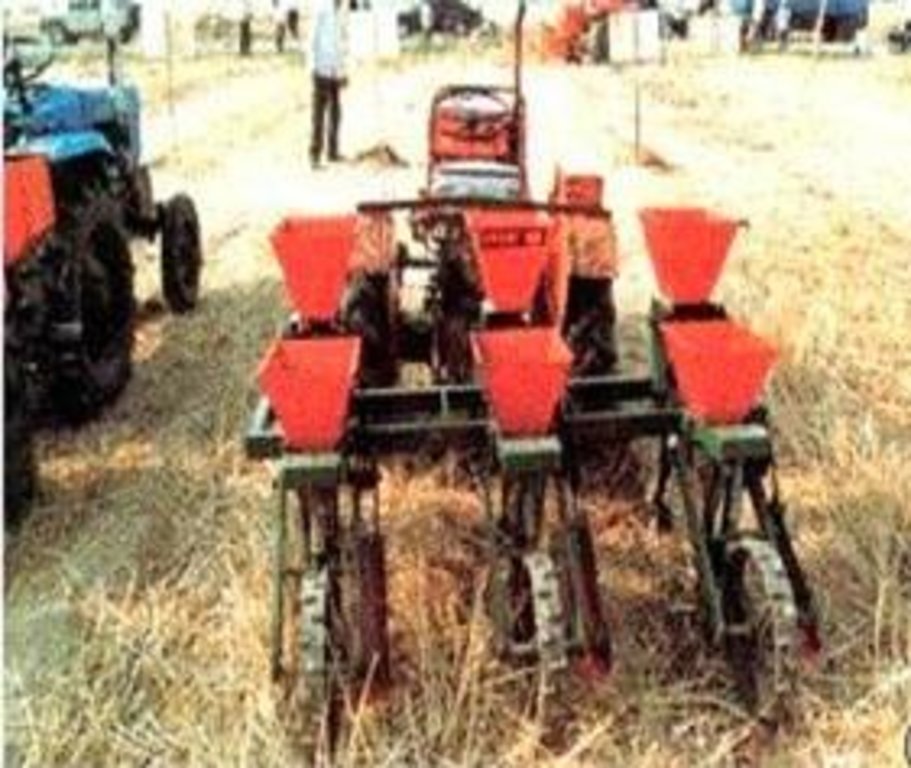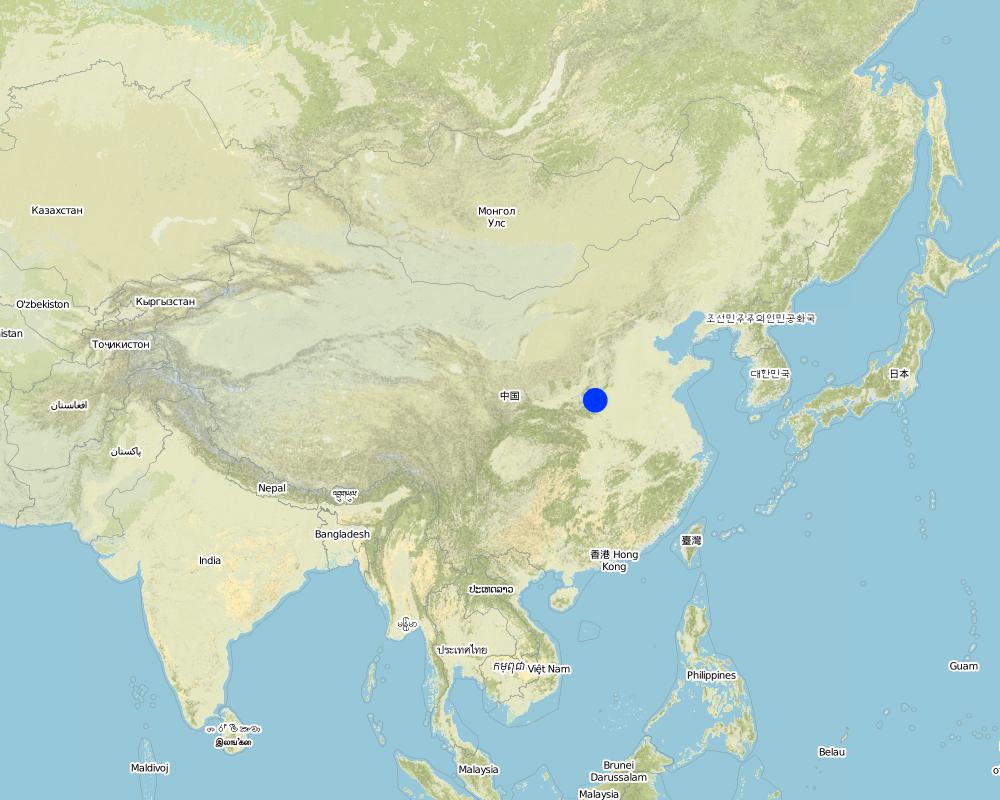Zero Tillage [中国]
- 创建:
- 更新:
- 编制者: Zhanguo Bai
- 编辑者: –
- 审查者: David Streiff, Alexandra Gavilano
No Tillage
technologies_969 - 中国
查看章节
全部展开 全部收起1. 一般信息
1.2 参与该技术评估和文件编制的资源人员和机构的联系方式
有助于对技术进行记录/评估的机构名称(如相关)
ISRIC World Soil Information (ISRIC World Soil Information) - 荷兰1.3 关于使用通过WOCAT记录的数据的条件
编制者和关键资源人员接受有关使用通过WOCAT记录数据的条件。:
是
1.5 参考关于SLM方法(使用WOCAT记录的SLM方法)的调查问卷

Zero Tillage [中国]
Zero tillage approach was developed to protect the soils from sealing rainfall, to achieve and maintain a open internal soil structure, to enhance biological processes in the soil, and to develop a means for safe disposal of any surface runoff that nevertheless will occur.
- 编制者: Zhanguo Bai
2. SLM技术的说明
2.1 技术简介
技术定义:
Zero tillage technology was developed to protect the soils from sealing rainfall, to achieve and maintain a open internal soil structure, to enhance biological processes in the soil, and to develop a means for safe disposal of any surface runoff that nevertheless will occur.
2.2 技术的详细说明
说明:
No tillage with residual mulching is developed to minimally disturb soil structure, directly to sow in the residual mulching covered soils. The crop system is rotated. It is used to maintain the soil moisture and particles that would be moved by runoff and improve soil fertility.
2.3 技术照片
2.5 已应用该技术的、本评估所涵盖的国家/地区/地点
国家:
中国
区域/州/省:
Henan province
具体说明该技术的分布:
- 均匀地分布在一个区域
如果技术均匀分布在一个区域,则指定覆盖的区域(单位为平方千米):
800.0
如果不知道精确的区域,请注明大致覆盖的区域:
- 100-1,000 平方千米
注释:
Total area covered by the SLM Technology is 800 km2.
This technique has been successfully applied in the slope farmland, especially in the Loess Plateau and in the dry-semidry regions in the NW China. It is an ideal approach to infiltrate all precipitation in soils and reduce soil erosion and water loss in slope farmland.
Map
×2.6 实施日期
如果不知道确切的年份,请说明大概的日期:
- 不到10年前(最近)
2.7 技术介绍
详细说明该技术是如何引入的:
- 通过项目/外部干预
注释(项目类型等):
USA, Canada
3. SLM技术的分类
3.2 应用该技术的当前土地利用类型

农田
- 一年一作
年作 - 具体指明作物:
- 谷物类 - 玉米
- 豆科牧草和豆类 - 豆子
- 油料作物 - 花生
- wheat
每年的生长季节数:
- 1
具体说明:
Longest growing period in days: 180Longest growing period from month to month: Apr - SepSecond longest growing period in days: 90Second longest growing period from month to month: Jun - Sep
注释:
Major land use problems (compiler’s opinion): Traditional till farming (multi-till system) has made soil loose and easily being moved on the dry and semi-dry slope farmland. No coverage exist after harvest and till leading to serious erosion. Meanwhile less and less organic fertilizer is applied and replaced by increase in chemical fertilizer use so that soil fertility and crop quality decline.
Major land use problems (land users’ perception): More and more input are needed to maintain stable yield, quality of the crops and fruits are declining.
Type of cropping system and major crops comments: After harvest of wheat in June, corn or peanut or bean are saw and harvest in later autumn
3.4 供水
该技术所应用土地的供水:
- 雨养
注释:
Water supply: rainfed, mixed rainfed - irrigated
3.5 该技术所属的SLM组
- 最小的土壤扰动
3.6 包含该技术的可持续土地管理措施

农艺措施
- A3:土壤表面处理
注释:
Main measures: agronomic measures
Type of agronomic measures: mulching, zero tillage / no-till
3.7 该技术强调的主要土地退化类型

土壤水蚀
- Wt:表土流失/地表侵蚀
- Wg:冲沟侵蚀/沟蚀

土壤风蚀
- Et:表土流失

化学性土壤退化
- Cn:肥力下降和有机质含量下降(非侵蚀所致)

水质恶化
- Ha:干旱化
注释:
Main type of degradation addressed: Wt: loss of topsoil / surface erosion, Wg: gully erosion / gullying, Ha: aridification
Secondary types of degradation addressed: Et: loss of topsoil, Cn: fertility decline and reduced organic matter content
Main causes of degradation: other human induced causes (specify) (agricultural causes - irrational tillage on the slopeland), land tenure (Land subdivision)
Secondary causes of degradation: other natural causes (avalanches, volcanic eruptions, mud flows, highly susceptible natural resources, extreme topography, etc.) specify (insufficient rainfall and not well distribution), Lack of enforcement of legislat./authority
3.8 防止、减少或恢复土地退化
具体数量名该技术与土地退化有关的目标:
- 防止土地退化
4. 技术规范、实施活动、投入和成本
4.1 该技术的技术图纸
技术规范(与技术图纸相关):
Technical knowledge required for field staff / advisors: moderate
Technical knowledge required for land users: moderate
Main technical functions: control of dispersed runoff: retain / trap, control of dispersed runoff: impede / retard, improvement of ground cover, increase in organic matter, increase of infiltration, water harvesting / increase water supply, water spreading, sediment retention / trapping, sediment harvesting, reduction in wind speed, improvement of soil structure, increase in soil fertility
Secondary technical functions: increase / maintain water stored in soil
Mulching
Material/ species: film
Quantity/ density: 60% of sur
Remarks: alignment
Agronomic measure: residual cover
Material/ species: residual, straw
Quantity/ density: 80% of sur
Remarks: mean
Zero tillage / no-till
Remarks: Leaving residual after havest
4.2 有关投入和成本计算的一般信息
具体说明成本计算所用货币:
- 美元
注明雇用劳工的每日平均工资成本:
5.00
4.4 技术建立所需要的费用和投入
注释:
Duration of establishment phase: 96 month(s)
4.5 维护/经常性活动
| 活动 | 时间/频率 | |
|---|---|---|
| 1. | applying fertilizer | after harvest / each cropping season |
| 2. | Sowing using no-till machine | after harvest / each cropping season |
| 3. | weeding | crop growing / each cropping season |
4.6 维护/经常性活动所需要的费用和投入(每年)
注释:
Machinery/ tools: No-till machine, tractor
Subsidy is needed at the beginning of the SWC implementation.
4.7 影响成本的最重要因素
描述影响成本的最决定性因素:
Zero tillage machine and tractor
5. 自然和人文环境
5.1 气候
年降雨量
- < 250毫米
- 251-500毫米
- 501-750毫米
- 751-1,000毫米
- 1,001-1,500毫米
- 1,501-2,000毫米
- 2,001-3,000毫米
- 3,001-4,000毫米
- > 4,000毫米
有关降雨的规范/注释:
646mm for Luoyang/Henan
农业气候带
- 半干旱
- 干旱
5.2 地形
平均坡度:
- 水平(0-2%)
- 缓降(3-5%)
- 平缓(6-10%)
- 滚坡(11-15%)
- 崎岖(16-30%)
- 陡峭(31-60%)
- 非常陡峭(>60%)
地形:
- 高原/平原
- 山脊
- 山坡
- 山地斜坡
- 麓坡
- 谷底
垂直分布带:
- 0-100 m a.s.l.
- 101-500 m a.s.l.
- 501-1,000 m a.s.l.
- 1,001-1,500 m a.s.l.
- 1,501-2,000 m a.s.l.
- 2,001-2,500 m a.s.l.
- 2,501-3,000 m a.s.l.
- 3,001-4,000 m a.s.l.
- > 4,000 m a.s.l.
说明该技术是否专门应用于:
- 不相关
关于地形的注释和进一步规范:
Hill slopes: SE part of the Loess Plateau, mainly hilly area
Plateau / plains: low proportion in the whole SWC applied area
Valley floors: small area in the whole SWC applied area but output high with better irrigation systems
Slopes moderate: There is not much terraces built in this area and slope degree remains natural status
Slopes hilly: This part of the slope land have been developed for cultivation due to increasing population
Slopes steep: It is used by mixed treatment of forest and crop land.
5.3 土壤
平均土层深度:
- 非常浅(0-20厘米)
- 浅(21-50厘米)
- 中等深度(51-80厘米)
- 深(81-120厘米)
- 非常深(> 120厘米)
土壤质地(表土):
- 中粒(壤土、粉土)
- 细粒/重质(粘土)
土壤质地(地表以下> 20厘米):
- 中粒(壤土、粉土)
表土有机质:
- 中(1-3%)
- 低(<1%)
如有可能,附上完整的土壤描述或具体说明可用的信息,例如土壤类型、土壤酸碱度、阳离子交换能力、氮、盐度等。:
Soil depth deep: In the area the soil parant material is loess with thickness.
Soil depth shallow: Mainly distributes in the mountain slope
Soil texture medium: The soil parent material is loess which is loose with porous structure of particle "point-prism contact".
Soil texture fine heavy: The loess mainly originates from aeolian deposition.
Topsoil organic matter medium: organic matter is applied.
Topsoil organic matter low: mainly loess (earth) with little organic matter applied in the area
Soil fertility is low or very low and little or very little organic matter is applied in the area
Soil texture medium: The soil parent material is loess which is loose with porous structure of particle "point-prism contact".
Soil texture fine: The loess mainly originates from aeolian deposition.
Soil drainage is medium because the soil (earth) is loose.
Soil water storage is low or medium: No mulching on the soil surface and high evaporation and low under gound level.
5.6 应用该技术的土地使用者的特征
非农收入:
- 收入的10-50%
相对财富水平:
- 平均水平
- 丰富
机械化水平:
- 畜力牵引
- 机械化/电动
说明土地使用者的其他有关特征:
Population density: 100-200 persons/km2
Annual population growth: 0.5% - 1%
20% of the land users are rich and own 20% of the land (generally young person with skills).
80% of the land users are average wealthy and own 80% of the land.
Off-farm income specification: SWC users can get much more subsidies from governments or projects than those who take no SWC technology.
Animal traction is individual
Machines are shared or leased.
5.8 土地所有权、土地使用权和水使用权
土地所有权:
- 州
- 个人,有命名
土地使用权:
- 租赁
- 个人
6. 影响和结论性说明
6.1 该技术的现场影响
生态影响
水循环/径流
地表径流
SLM之前的数量:
30
SLM之后的数量:
5
土壤
土壤流失
SLM之前的数量:
25
SLM之后的数量:
3
6.4 成本效益分析
技术收益与技术建立成本相比如何(从土地使用者的角度看)?
短期回报:
积极
长期回报:
非常积极
技术收益与技术维护成本/经常性成本相比如何(从土地使用者的角度看)?
短期回报:
稍微积极
长期回报:
非常积极
6.5 技术采用
- 11-50%
如若可行,进行量化(住户数量和/或覆盖面积):
800 families (35 percent)
在所有采用这项技术的人当中,有多少人是自发的,即未获得任何物质奖励/付款?:
- 11-50%
注释:
30% of land user families have adopted the Technology with external material support
600 land user families have adopted the Technology with external material support
Comments on acceptance with external material support: estimates
5% of land user families have adopted the Technology without any external material support
200 land user families have adopted the Technology without any external material support
Comments on spontaneous adoption: estimates
There is a strong trend towards spontaneous adoption of the Technology
Comments on adoption trend: The technique can bring ecological, social and economic benefits
7. 参考和链接
7.1 信息的方法/来源
7.2 参考可用出版物
标题、作者、年份、ISBN:
Report of ninth-Five plan project on Dryland Farming. Jan. 2002.
可以从哪里获得?成本如何?
internal reference
标题、作者、年份、ISBN:
Introduction of Luoayng physicography. 2000.
可以从哪里获得?成本如何?
unpublished materials
标题、作者、年份、ISBN:
No-till farming for sustainable rural development. 2002.
可以从哪里获得?成本如何?
World Bank
标题、作者、年份、ISBN:
A road map from conventional to no-till farming. 2002.
可以从哪里获得?成本如何?
World Bank
标题、作者、年份、ISBN:
Conservation agriculture. 2001.
可以从哪里获得?成本如何?
FAO
链接和模块
全部展开 全部收起链接

Zero Tillage [中国]
Zero tillage approach was developed to protect the soils from sealing rainfall, to achieve and maintain a open internal soil structure, to enhance biological processes in the soil, and to develop a means for safe disposal of any surface runoff that nevertheless will occur.
- 编制者: Zhanguo Bai
模块
无模块




